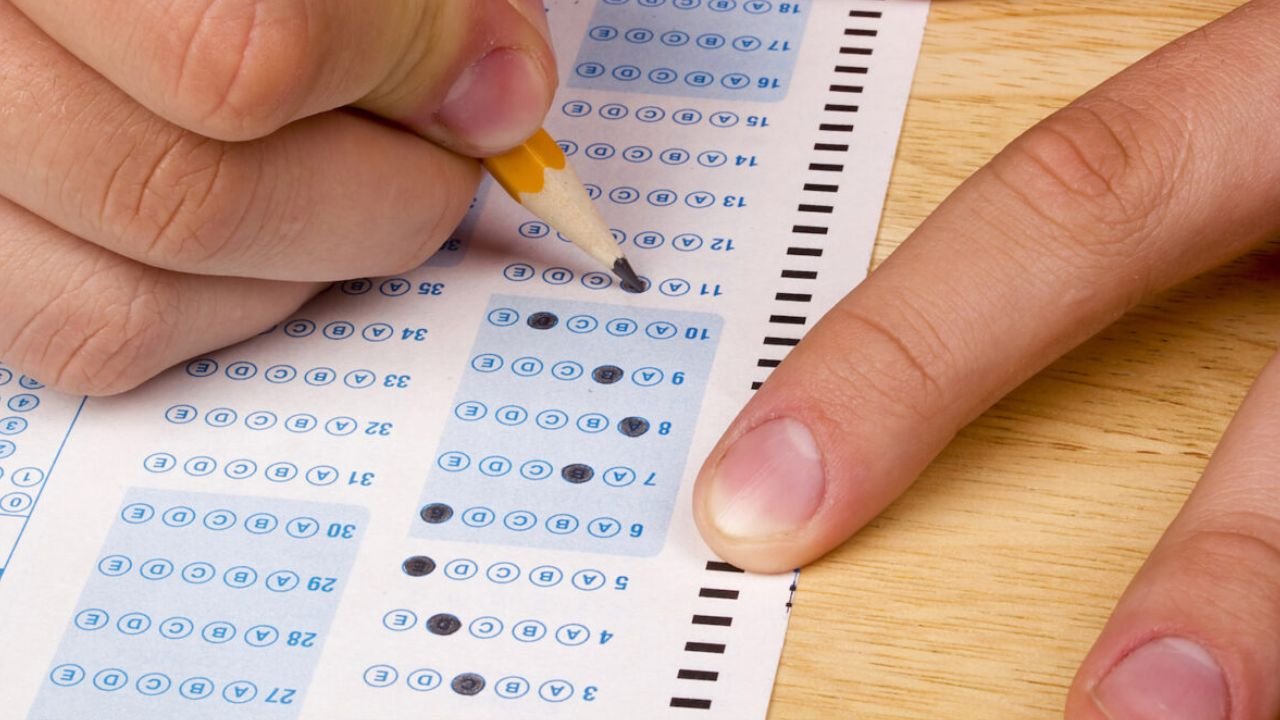The digital SAT format has significantly changed the traditional SAT. Knowing the latest digital format for the SAT will help students prepare effectively for the best results. This updated exam shows how traditional pen-and-paper testing has evolved to assess skills efficiently while reducing stress. Since March 2024, the SAT has been fully digital worldwide. It now runs on a shorter, adaptive format designed to provide accurate results in less time. . If you’re practicing for the new test, taking a SAT Practice Test is the best way to get familiar with the structure.
Overview of the Digital SAT Format
Here is a brief overview of the digital SAT format from the official College Board website. Students often wonder How Long is Digital SAT compared to the paper version. The answer is 2 hours and 14 minutes (excluding breaks), which is shorter than the old 3-hour format.
| Section | Number of Questions | Time Limit |
|---|---|---|
| Reading and Writing – Module 1 | 27 | 32 minutes |
| Reading and Writing – Module 2 | 27 | 32 minutes |
| Break | — | 10 minutes |
| Math – Module 1 | 22 | 35 minutes |
| Math – Module 2 | 22 | 35 minutes |
| Total | 98 | 2 hours 14 minutes (excluding break) |
If you are looking for how many questions are on the digital SAT, then there are 98 total questions. The Digital version of the SAT has the same score range, 400 to 600, but the total time is reduced from 3 hours to about 2 hours and 14 minutes to complete. The test has two sections:
- Reading & Writing (RW)
- Math
Each section has two modules. The student’s performance in the first section will determine how the 2nd module will be. Doing well in the first module will result in a harder 2nd module.
Digital SAT Format Sections Explained
Here is the explanation of the Digital SAT sections. The new format only has two sections: Reading & Writing and Math. Unlike the old exam, you don’t need to worry about SAT Section 5 (experimental section), since it has been removed from the digital version.
Reading & Writing Section
Reading and Writing evaluate comprehension and logical reasoning by analysing texts across fields. The reading and writing section is organized into four basic content domains. They align with the skills necessary for college readiness and career success:
R&W Format
- 2 modules — 27 questions each
- Time per module: 32 minutes
- Total: 54 questions, 64 minutes
- Adaptive format: Your performance in the first module affects the difficulty of the second module.
Types of questions on the SAT’s Reading and Writing sections
These are the digital SAT question types that you will have to go through.
Idea Comprehension:
This tests how well you can understand and analyze the paragraph or passage (like a table or chart). You will have to find the main ideas, find details, and connect information from different sources.
Craft and Structure:
With these question types, they will check your vocabulary knowledge and your ability to figure out a word’s meaning from context. You’ll also answer questions about how a text is organized and what the author wants to say, and how two related passages connect.
Ideas Expression:
You will have to provide a clear and effective message after reading the passage. Your idea of expression should be better suited to the audience and serve the purpose.
Standard English Conventions:
This will evaluate your understanding of grammar, sentence structure, and punctuation. You’ll edit sentences to make sure they follow standard written English rules.
Skills measured in Reading and Writing
In Reading and Writing, each domain has subcategories called skills. They have different question types, but a single skill can have multiple question types. Check the following table for skill information.
| Section | Skill | Distribution |
|---|---|---|
| Information and Ideas | Central Ideas and Details, Command of Evidence (Textual), Command of Evidence (Quantitative), Inferences | 26% (12–14 questions) |
| Craft and Structure | Words in Context, Text Structure and Purpose, Cross-Text Connections | 28% (13–15 questions) |
| Expression of Ideas | Rhetorical Synthesis, Transitions | 20% (8–12 questions) |
| Standard English Conventions | Boundaries, Form, Structure, and Sense | 26% (11–15 questions) |
Math Section
The Math module of the Digital SAT evaluates a student’s ability to apply mathematical concepts to real-world scenarios and academic problems. It includes both multiple-choice and student-produced response (open-ended) questions. A calculator is allowed for the entire section, and students can also opt for a Desmos graphing calculator or bring their own approved calculator. If you’re preparing, check out our guide on Using Desmos to Your Advantage in the Digital SAT to solve problems faster and more efficiently.
Types of questions on the SAT’s Math Section
The Math section is divided into four key domains:
Algebra:
This assesses the ability to analyze, solve, and create linear equations and inequalities, as well as systems of linear equations.
Advanced Math:
This measures readiness for higher-level mathematics by covering nonlinear equations such as quadratic, exponential, and rational functions.
Problem-Solving and Data Analysis:
This assesses quantitative literacy, including interpreting graphs, working with ratios and proportions, and analyzing statistical data.
Geometry and Trigonometry:
This emphasizes spatial reasoning and problem-solving involving shapes, volumes, coordinate geometry, angles, and trigonometric ratios.
Skills measured in Math
Each test module includes all content areas, and it has questions sorted from the easiest to the hardest. Within each domain, questions are further divided into specific skills to assess targeted competencies effectively. Check the following table for further explanation:
Adaptive Testing For the Digital SAT Explained
The digital SAT comes with adaptive difficulty. For many students, this concept was new. They often search for is the SAT is adaptive. And the answer is “Yes”. Digital SAT is adaptive as it uses section-level adaptive testing. This means:
- Module 1 (in each section) contains a mix of easy, medium, and hard questions.
- Based on your score in Module 1, the test delivers Module 2 at either a higher or lower difficulty.
- Harder second modules allow higher score potential, while easier ones limit the top score range.
Adaptive Testing Benefits For Students:
- Shorter test time without losing accuracy
- Tailored question difficulty that reflects performance
- Fewer total questions (98 compared to 154 on the paper SAT)
Strategies for Students In Digital SAT Prep
These strategies will surely be helpful for students preparing for the digital SAT format. For students who want a personalized study plan, SAT Private Coaching can help target weak areas and build confidence. If you’re located in the Northeast, enrolling in SAT Prep in New Jersey programs can give you access to expert tutors familiar with the adaptive SAT format.
Master adaptive strategy:
Your first module matters in adaptive tests. Aim for accuracy early so that the second module will get harder.
Practice real question types:
Focus on official SAT question types, not outdated formats.
Integrate SAT grammar practice:
Many students lose points to punctuation and sentence structure errors, which are easier to fix than comprehension gaps.
Build contextual vocabulary:
SAT vocab words now appear in short passages, so practice understanding meaning from context, not just memorization.
Time management:
Divide your time evenly. In Reading & Writing, aim for 70 seconds per question; in Math, about 95 seconds. Opt for a SAT practice test for stronger preparation.
Use the digital tools:
The test interface includes a built-in calculator, annotation features, and flag-for-review options.
FAQs About Digital SAT Format?
Let’s answer some of the most common questions about the SAT and digital SAT.
Q: What type of questions are on the SAT?
The Digital SAT includes reading comprehension, vocabulary-in-context, grammar, and math problem-solving. Math covers algebra, geometry, trigonometry, and data analysis.
Q: Is the SAT adaptive?
Yes. Both Reading & Writing and Math use two adaptive modules.
Q: How many questions are on the digital SAT?
There are 98 total questions, 54 in Reading & Writing, and 44 in Math.
Q: What are the SAT reading question types?
They include evidence-based reading, vocabulary in context, synthesis, and reasoning questions.
Q: How should I practice SAT grammar?
Focus on punctuation, sentence structure, and standard English conventions. Use official SAT grammar practice test materials for accuracy.
Bottom Line
The digital SAT format features two adaptive sections. Math, Reading, and Writing, which are completed in just over two hours. With fewer questions, a shorter duration, and adaptive difficulty, the new format is efficient and precise. Students who want to get top scores should aim for the early module. At Ivy learning, we help students build skills, timing, strategy, and confidence to perform well in this modern SAT environment.











